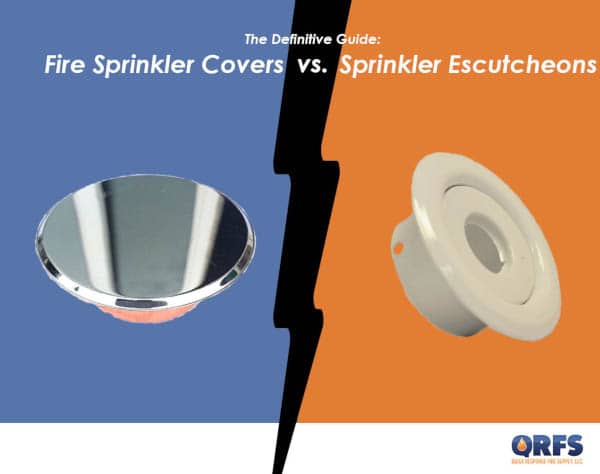Learn the difference between fire sprinkler escutcheons and the cover plates used in concealed sprinklers
The fire sprinkler industry is rife with jargon, and hardly anybody outside of the industry understands most of it. Beyond sprinkler contractors, fitters, firefighters, and other fire protection professionals is an even larger market consisting of building and homeowners, maintenance professionals, inspectors, media personalities, and even politicians who either don’t know common terms or create new words for fire sprinkler system components. In this blog, we dive into the names and use cases for two of the most confused part names: fire sprinkler covers and fire sprinkler escutcheons.
Fire sprinkler covers
Let’s start with fire sprinkler covers, otherwise sometimes called sprinkler concealers, sprinkler cover plates, or (incorrectly) sprinkler caps. A fire sprinkler cover is a thin metal plate connected to a frame via a temperature-responsive solder designed to melt at a specified temperature. When it’s installed, the cover plate provides an aesthetic and functional barrier between the sprinkler head and the room’s occupants, as the diagram below illustrates.
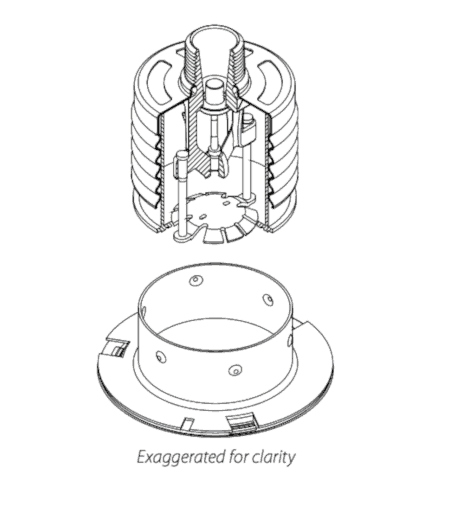
The cover plate is a part of the concealed sprinkler’s assembly. Beyond the benefit of looks and decor, it also provides additional protection for the sprinkler by deflecting any objects that might unintentionally hit it and keeps the majority of dust, dirt, and debris away from the head itself. During a fire event, the cover plate’s solder melts at a temperature that’s usually about 20 degrees Fahrenheit lower than the fire sprinkler’s activation temperature. The plate then harmlessly falls to the ground, allowing the sprinkler to deploy and activate at its specified temperature. In the most common concealed models, the cover plate falls off at around 135 degrees Fahrenheit and the sprinkler’s thermal sensor activates at 155 degrees Fahrenheit, though other temperatures are available.
Here are some important aspects to note about fire sprinkler covers:
- Each manufacturer designs their own cover plates, and they are not interchangeable with other manufacturers’ sprinklers. Before ordering replacements, determine the manufacturer of your sprinkler and then order cover plates that match both the brand and specific model. If your sprinkler is from Tyco, Viking, Reliable Victaulic, or Senju Sprinkler, we have inventory ready to go. If it’s not, contact us.
- Under no circumstances can you paint a fire sprinkler cover, though it is possible to order custom finishes from the manufacturer.
- When replacing cover plates, it is crucial to procure the correct temperature plate — usually, about 20 degrees Fahrenheit lower than the sprinkler itself.
Not sure which fire sprinkler cover plate you need? Read this simple guide to finding the right replacement cover plate.
Fire sprinkler escutcheons
There is probably no other fire sprinkler product with more name variations than the sprinkler escutcheon. Beauty rings, trim rings, sleeves, 401s, adjustable, extended, cups, and even what’s sometimes referred to as a ‘donkey dick’ are all variations on the traditional escutcheon name. The purpose of a sprinkler escutcheon is two-fold: first, it aesthetically surrounds the base of the sprinkler, adding what amounts to a decorative trim while covering the cut-out in the ceiling or wall. But escutcheons are also functional, as they block heat from rising and escaping into the wall or ceiling, which can delay the activation of a sprinkler. For our purposes, we’re going to categorize fire sprinkler escutcheons into some broad categories: flat escutcheons, recessed escutcheons, one-piece escutcheons, split-ring escutcheons, and adjustable escutcheons.
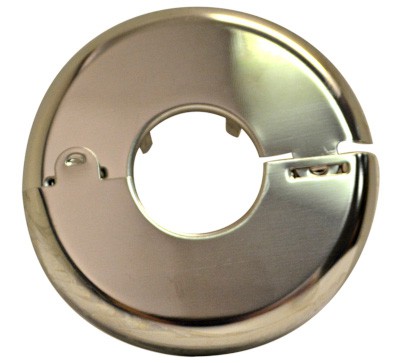
Flat escutcheons are, as you probably guessed, flat. The sprinkler itself is neither recessed nor additionally extended from the wall or ceiling, enabling the flat escutcheon to cover properly the wall or ceiling cut-out.
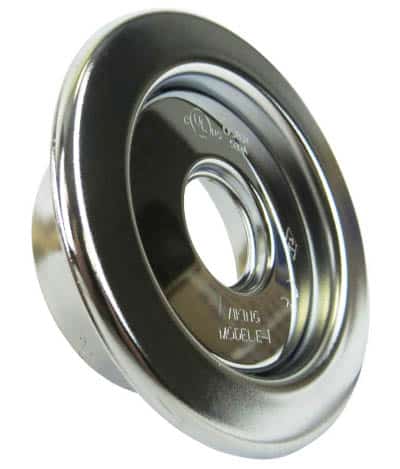
Recessed escutcheons sit at a specified depth, with a decorative ring covering the cutout while the inner ring remains around the base of the recessed sprinkler. Recessed sprinklers are common in schools, offices, etc. – nearly anywhere with drywall or ceiling tiles in a smaller room. See recessed escutcheons here.
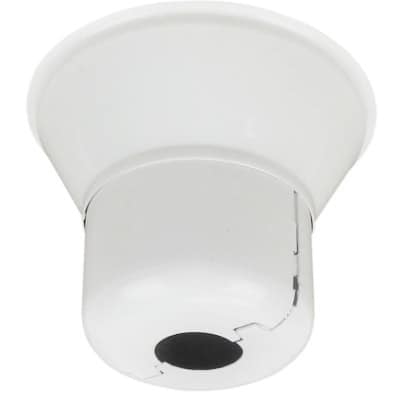
Adjustable escutcheons have a cup that extends to a specified distance and, as the name implies, are adjusted to encase a sprinkler that does not sit flush or recessed with the wall or ceiling. See adjustable escutcheons here.
The choice of the escutcheon is dependent on the installation and design of the sprinkler system. As a quick reminder, all sprinklers have a spray discharge pattern that covers a set area within a room, as demonstrated by the image below.
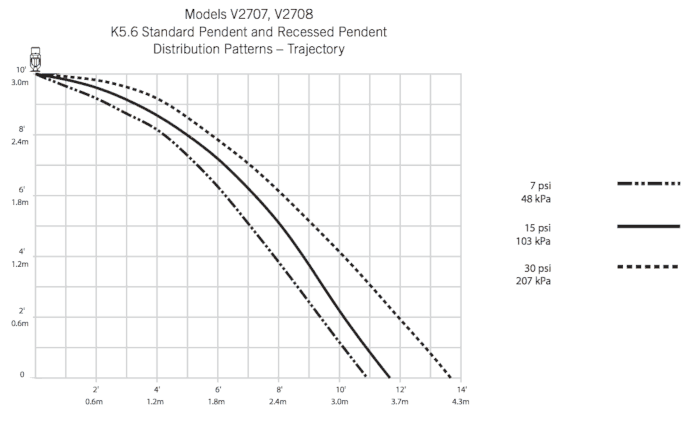
Often, the sprinkler itself may be extended beyond the wall or ceiling to expand its coverage area and cover the room with the fewest number of sprinklers. In that situation, an adjustable escutcheon can make the most sense. For example, hotel rooms often have only one or two sprinklers covering the entire room. Because the sprinklers are away from the wall, water can soak the largest possible area in a fire event.
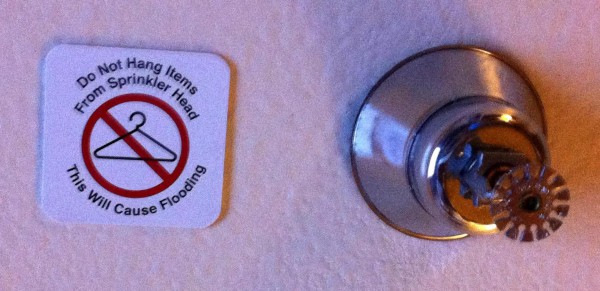
Most escutcheons are installed during system fitting and are not replaceable as-is without draining the system and removing the sprinkler head. However, another option exists: retrofit, or split, escutcheons. Again, as the name implies, these are escutcheons designed to be installed after-the-fact (retrofit) and are split, so removal of the sprinkler is not required. Here’s a handy guide to installing retrofit escutcheons.
As you can see in the table below, QRFS offers both standard and retrofit options available in multiple finishes — but just like the cover plates, you cannot paint them
So now let’s put our two sprinkler components head-to-head.
- A sprinkler cover (aka cup, cover plate, or concealer) is part of the concealed sprinkler head assembly, designed specifically for a manufacturer’s model, and has a thermal element (solder) that responds to fire by falling out of the sprinkler’s way just before sprinkler activation.
- An escutcheon (aka beauty ring, trim ring), on the other hand, provides a decorative and functional trim around the sprinkler that covers the cutout in the wall or ceiling.
Both are replaceable, though with different requirements.
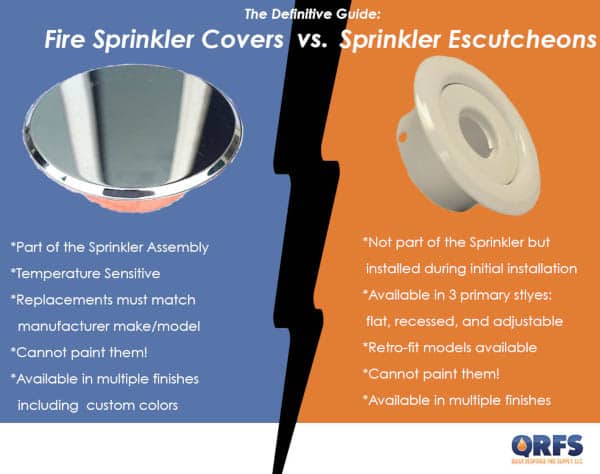
Congratulations! Now you’re equipped with the knowledge and jargon necessary to correctly identify cover plates and escutcheons. If you need replacements:
Shop QRFS’s selection of fire sprinkler cover plates.
Check out our selection of fire sprinkler escutcheons.
If you have further questions, feel free to call us at 888-361-6662 or contact us here.


